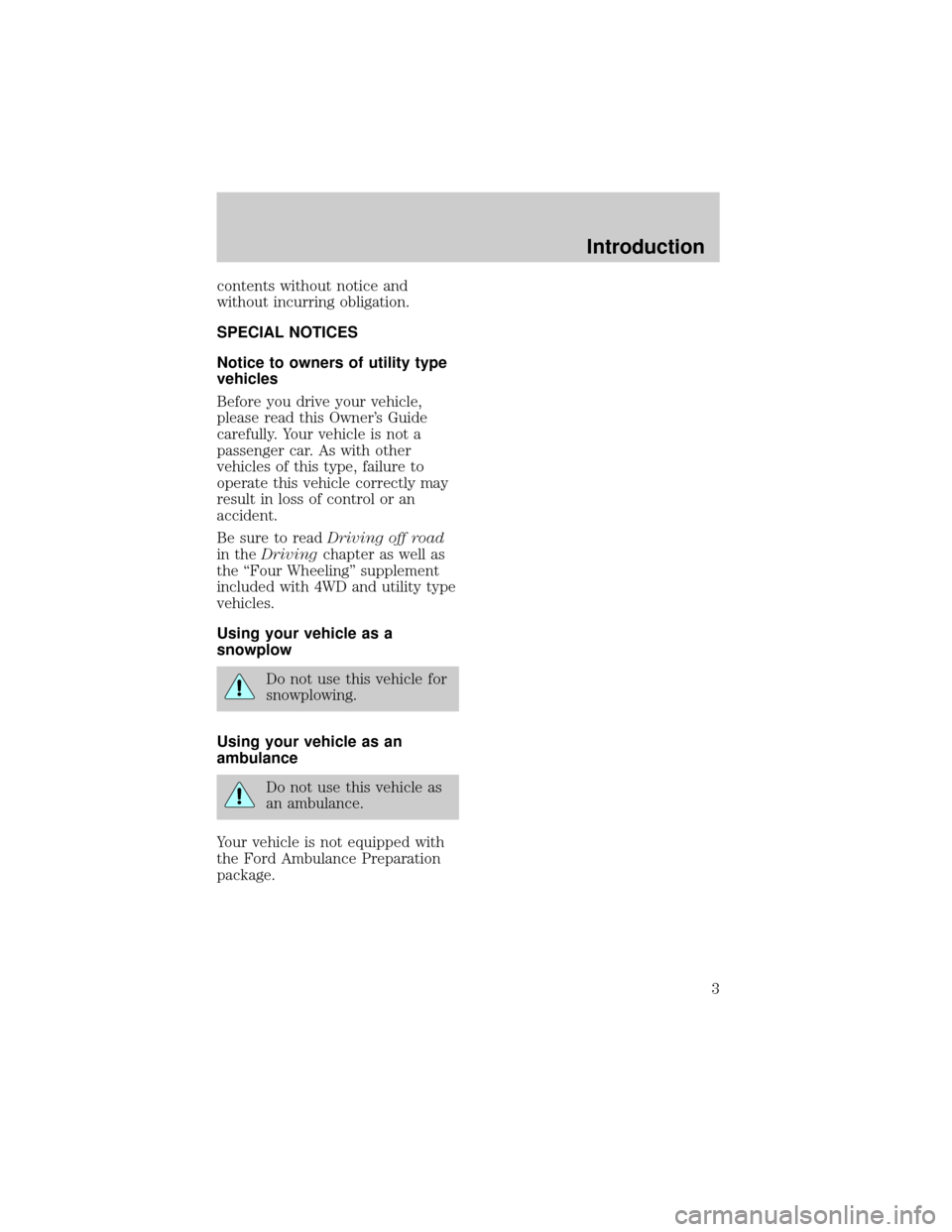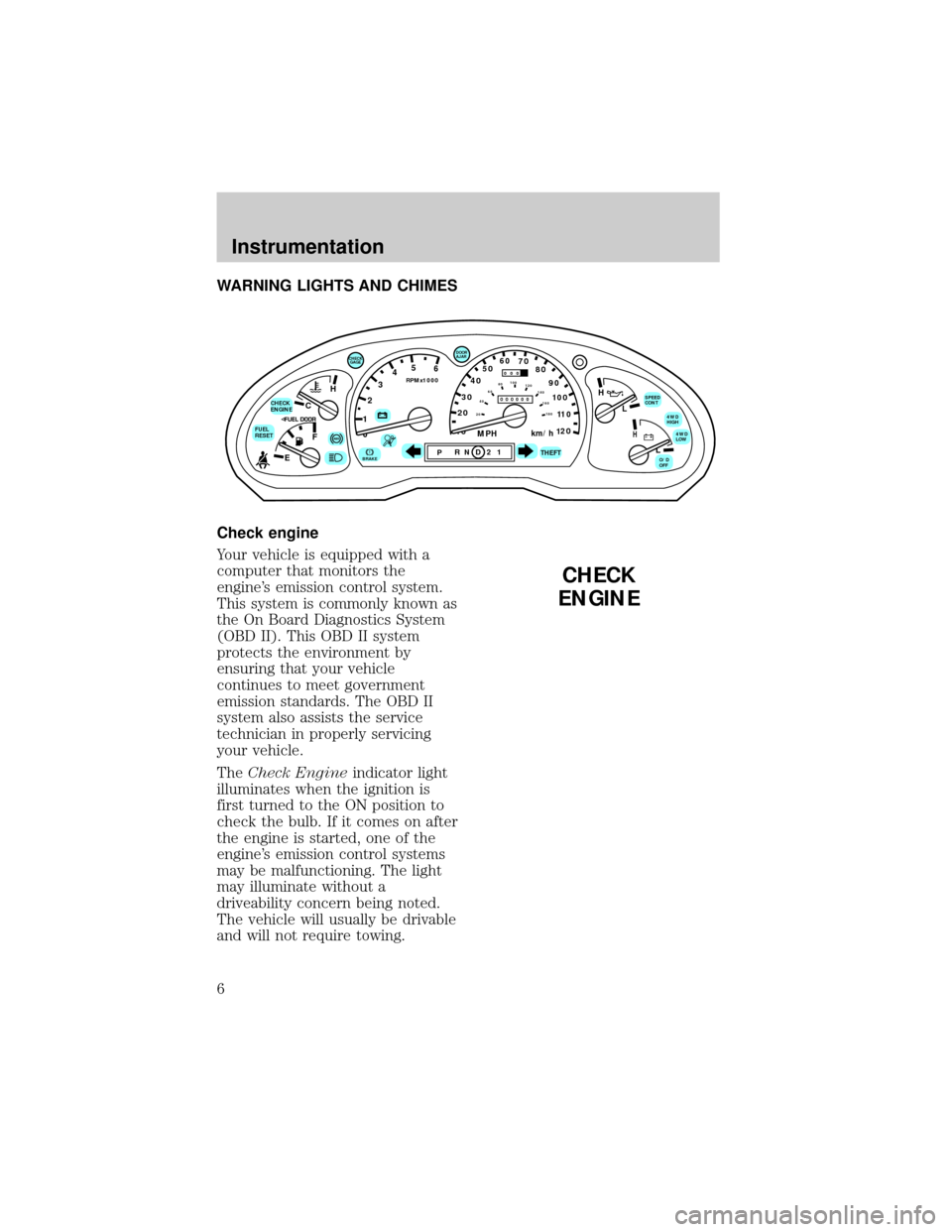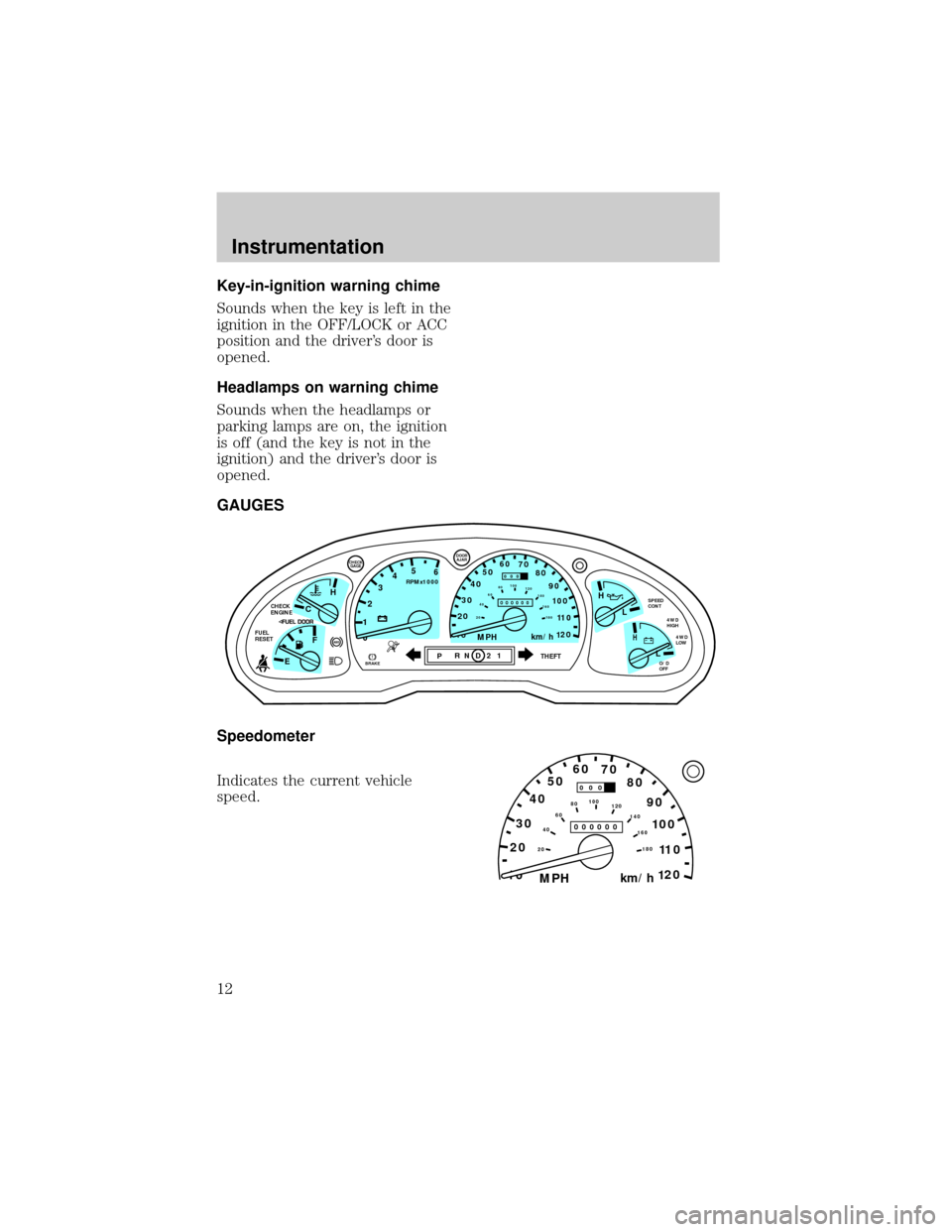4WD Mercury Mountaineer 1998 Owner's Manuals
[x] Cancel search | Manufacturer: MERCURY, Model Year: 1998, Model line: Mountaineer, Model: Mercury Mountaineer 1998Pages: 216, PDF Size: 1.72 MB
Page 3 of 216

contents without notice and
without incurring obligation.
SPECIAL NOTICES
Notice to owners of utility type
vehicles
Before you drive your vehicle,
please read this Owner's Guide
carefully. Your vehicle is not a
passenger car. As with other
vehicles of this type, failure to
operate this vehicle correctly may
result in loss of control or an
accident.
Be sure to readDriving off road
in theDrivingchapter as well as
the ªFour Wheelingº supplement
included with 4WD and utility type
vehicles.
Using your vehicle as a
snowplow
Do not use this vehicle for
snowplowing.
Using your vehicle as an
ambulance
Do not use this vehicle as
an ambulance.
Your vehicle is not equipped with
the Ford Ambulance Preparation
package.
Introduction
3
Page 6 of 216

WARNING LIGHTS AND CHIMES
Check engine
Your vehicle is equipped with a
computer that monitors the
engine's emission control system.
This system is commonly known as
the On Board Diagnostics System
(OBD II). This OBD II system
protects the environment by
ensuring that your vehicle
continues to meet government
emission standards. The OBD II
system also assists the service
technician in properly servicing
your vehicle.
TheCheck Engineindicator light
illuminates when the ignition is
first turned to the ON position to
check the bulb. If it comes on after
the engine is started, one of the
engine's emission control systems
may be malfunctioning. The light
may illuminate without a
driveability concern being noted.
The vehicle will usually be drivable
and will not require towing.
C
012345
6
RPMx1000
ABS!BRAKE
CHECK
ENGINE
FUEL
RESET
EFH
H
H
PRN D 2 1THEFT
SPEED
CONT
4WD
HIGH
4WD
LOW
O/D
OFFL
L
10MPH 205060
70
304080
90
km/h
0 0 0
10 100
1
20
1
0 0 0 0 0 0406080100
120
140
160
180
20
DOOR
AJAR
CHECK
GAGE
CHECK
ENGINE
Instrumentation
6
Page 12 of 216

Key-in-ignition warning chime
Sounds when the key is left in the
ignition in the OFF/LOCK or ACC
position and the driver's door is
opened.
Headlamps on warning chime
Sounds when the headlamps or
parking lamps are on, the ignition
is off (and the key is not in the
ignition) and the driver's door is
opened.
GAUGES
Speedometer
Indicates the current vehicle
speed.
C
012345
6
RPMx1000
ABS
CHECK
ENGINE
FUEL
RESET
EFH
H
H
PRN D 2 1THEFT
SPEED
CONT
4WD
HIGH
4WD
LOW
O/D
OFFL
L
10MPH 205060
70
304080
90
km/h
0 0 0
10 100
1
20
1
0 0 0 0 0 0406080100
120
140
160
180
20
DOOR
AJAR
CHECK
GAGE
!BRAKE
10MPH 205060
70
304080
90
km/h
0 0 0
10 100
1
20
1
0 0 0 0 0 0406080100
120
140
160
180
20
Instrumentation
12
Page 25 of 216

4WD CONTROL (IF EQUIPPED)
This control operates the 4WD.
Refer toFour-wheel drive (4WD)
operationin theDrivingchapter
for more information.
AUDIO SYSTEM
Refer to the ªAudio Guideº in your
owner portfolio.
TURN SIGNAL CONTROL
²Push down to activate the left
turn signal.
²Push up to activate the right
turn signal.
HIGH
LOW AUTO
Controls and features
25
Page 96 of 216

²Make sure the parking brake is
set.
²Make sure the gearshift is in P
(Park).
3. Turn the key to 4 (ON) without
turning the key to 5 (START).
3
2
1
5
4
C
012345
6
RPMx1000ABS
CHECK
ENGINE
DOOR
AJAR
EFH
H
H
PRN D 2 1THEFT
SPEED
CONT
4WD
4WD
LOW
O/D
OFFL
L
10MPH 205060
70
304080
90
km/h
0 0 0
10 100
1
20
1
0 0 0 0 0 0406080100
120
140
160
180
20
AJAR
CHECK
GAGE
!BRAKE
Starting
96
Page 111 of 216

the vehicle decelerates to the
proper vehicle speed.
CONTROL-TRAC AUTOMATIC
FOUR-WHEEL DRIVE SYSTEM
(IF EQUIPPED)
The 4WD system uses all four
wheels to power the vehicle. This
increases traction, enabling you to
drive your 4x4 over terrain and
road conditions not normally
traveled by two-wheel drive
vehicles.
Power is supplied to all four
wheels through a transfer case that
allows you to select a four-wheel
drive mode best suited for your
current driving conditions.
Positions of the Control-Trac
system
The Control-Trac system functions
in three modes:
²The 4WD AUTO mode provides
four-wheel drive with full power
delivered to the rear axle, and
to the front axle as required for
increased traction. This is
appropriate for normal on-road
operating conditions, such as
dry road surfaces, wet
pavement, snow and gravel.
HIGH
LOW AUTO
Driving
111
Page 112 of 216

²The 4WD HIGH mode provides
four-wheel drive with full power
to both axles. It is only intended
for severe winter or off-road
conditions, such as deep snow
and ice (where no dry or wet
pavement remains uncovered),
and shallow sand.
²The 4WD LOW mode supplies
four-wheel drive with full power
to both axles and includes a
lower gear ratio for low-speed. It
is only intended for off-road
applications that require extra
power including deep sand,
steep grades and pulling a boat
and trailer out of the water.
The vehicle should not be
operated in 4WD HIGH and
4WD LOW on dry or merely wet
pavement. Doing so will
produce excessive noise,
increase tire wear and may
damage driveline components.
These modes are intended for
use only on consistently
slippery or loose surfaces.
If your vehicle is equipped with
4WD or AWD, a spare tire of a
different size than the road
tires should never be used.
Such a tire could result in
damage to driveline
components and make the
vehicle difficult to control.HIGH
LOW AUTO
HIGH
LOW AUTO
Driving
112
Page 113 of 216

Utility and four-wheel
drive vehicles arenot
designed for cornering at speeds
as high as passenger cars any
more than low-slung sports cars
are designed to perform
satisfactorily under off-road
conditions. Avoid sharp turns or
abrupt maneuvers in these
vehicles.
Using the Control-Trac system
Shifting between 4WD AUTO
and 4WD HIGH
When you move the control to
4WD HIGH, the indicator light will
illuminate in the instrument
cluster. When you move the
control to 4WD AUTO, the
indicator light will turn off.
Either shift can be done at a stop
or while driving at any speed.
Shifting from 4WD AUTO or
4WD HIGH to 4WD LOW
1. Bring the vehicle to a stop.
2. Depress the brake.
3. Place the gearshift in N
(Neutral) (automatic transmission)
or depress the clutch (manual
transmission).
4. Move the 4WD control to the
4WD LOW position.
HIGH
LOW AUTO
HIGH
LOW AUTO
Driving
113
Page 114 of 216

Shifting from 4WD LOW to 4WD
AUTO or 4WD HIGH
1. Bring the vehicle to a stop.
2. Depress the brake.
3. Place the gearshift in N
(Neutral) (automatic transmission)
or depress the clutch (manual
transmission).
4. Move the 4WD control to the
4WD AUTO or 4WD HIGH position.
Driving off-road with 4WD
Your vehicle is specially equipped
for driving on sand, snow, mud and
rough terrain and has operating
characteristics that are somewhat
different from conventional
vehicles, both on and off the road.
Maintain steering wheel control at
all times, especially in rough
terrain. Since sudden changes in
terrain can result in abrupt
steering wheel motion, make sure
you grip the steering wheel from
the outside. Do not grip the
spokes.
Drive cautiously to avoid vehicle
damage from concealed objects
such as rocks and stumps.
You should either know the terrain
or examine maps of the area
before driving. Map out your route
before driving in the area. For
more information on driving
off-road, read the ªFour Wheelingº
supplement in your owner's
portfolio.HIGH
LOW AUTO
Driving
114
Page 117 of 216

hill before driving over the crest.
When climbing a steep hill, start in
a lower gear rather than
downshifting to a lower gear from
a higher gear once the ascent has
started. This reduces strain on the
engine and the possibility of
stalling.
When descending a steep hill,
avoid sudden braking. Rapid
pumping of the brake pedal will
help slow the vehicle and still
maintain steering control.
When speed control is on and you
are driving uphill, your vehicle
speed may drop considerably,
especially if you are carrying a
heavy load.
If vehicle speed drops more than
16 km/h (10 mph), the speed
control will cancel automatically.
Resume speed with accelerator
pedal.
If speed control cancels after
climbing the hill, reset speed by
pressing and holding the SET
ACCEL button (to resume speeds
over 50 km/h (30 mph).
Automatic transmissions may shift
frequently while driving up steep
grades. Eliminate frequent shifting
by shifting out of
(Overdrive)
into D (Drive).
Driving on snow and ice
A 4WD vehicle has advantages
over 2WD vehicles in snow and ice
but can skid like any other vehicle.
Driving
117